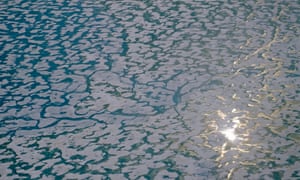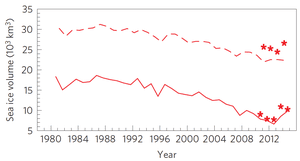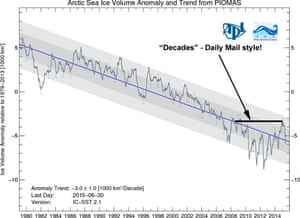Coverage of a recent paper on Arctic sea ice and climate change suggests conservative media can’t seem to grasp the concept of long-term trends

Shares
480
Comments
Cherry-picking is one of the five telltale techniques of climate change denial. By focusing on short-term blips in noisy data, those who want to maintain the status quo can distract from the long-term threats posed by climate change. Climate contrarians most frequently deploy this strategy using global temperature and Arctic sea ice data.
A recent study in Nature Geoscience concluded that, not surprisingly, there is a strong relationship between the summer temperatures in the Arctic (specifically the number of “melting degree days”), and the amount of sea ice that melts in a given year. 2013 happened to be a relatively cool year in the Arctic – the coolest since 2004. As a result, there was relatively little ice melt in 2013. The annual minimum Arctic sea ice extent and volume were their largest since at least 2009, or perhaps as far back as 2005, according to the data used in this new study.
The following figure from the paper is as clear as ice – while there was a short-term increase from 2012 to 2013, the Arctic has lost more than half its sea ice over the past three decades.
 Facebook Twitter Pinterest
Facebook Twitter Pinterest The following video by programmer Andy Lee Robinson also illustrates the dramatic rate of sea ice decline over the past 35 years.
Lead author Rachel Tilling was quite clear and explicit that while her study is good news in that Arctic sea ice could potentially recover if the planet eventually cools, the short-term blip is not indicative of such a recovery.
We do not want to suggest that this is a recovery in the long term. If you look at the long-term temperature trend in the Arctic, it’s upward, and if you look at the long-term volume trend, it’s downward. If temperatures continue to rise, volume is going to continue to decrease.
Indeed, the Arctic is the fastest-warming region on Earth precisely because of the sea ice “feedback.” Melting ice decreases the reflectivity of the Arctic surface, causing it to absorb more sunlight, warm faster, and melt more ice, which causes yet further warming in a vicious cycle. There are short-term natural variability wiggles on top of the trend, but the long-term Arctic sea ice decline is indisputable.
Although the Daily Mail news coverage of this paper was reasonably accurate, its editorial opinion piece about it was anything but. The opinion piece initially claimed the study showed “the northern ice-cap INCREASED by a staggering 41% in 2013 and, despite a modest shortage last year, is bigger than at any time for decades.”
That last statement was flat-out wrong. As noted above, the Arctic may have had more ice in 2009 than 2013, and certainly did in 2005, and every year before that. In short, the Daily Mail editorial staff tried to figure out the science and math by themselves, got it badly wrong, and eventually corrected the text after many, including Tilling, pointed out the error.

Now, although it doesn’t note the correction, the Mail editorial piece says that sea ice “is bigger than at any time for years” instead of decades. This statement was true in 2013, but is hardly notable. The rest of the piece rants against efforts to reduce greenhouse gas emissions, and was not changed after the Mail corrected its error.
Writing for the Telegraph on the same study, Christopher Booker made even more mistakes than the Daily Mail. There are too many to address here, but in two particular egregious examples Booker claims,
Polar bear numbers are rising, not falling. Temperatures in Greenland have shown no increase for decades.
I debunked the polar bears myth in the Denial101x lecture video below (which also discusses Arctic sea ice). Greenland has warmed incredibly rapidly, at a rate of 0.36C per decade since 1960, and a whopping 1.1C per decade since 1990. The latter period represents a warming rate in Greenland more than six times faster than the global average.
This is far from the first time the Daily Mail and Telegraph have gotten Arctic climate science wrong. In fact, in 2013, both ran similar articles focusing on the short-term noise and ignoring the long-term trend. David Rose, who wrote the 2013 Mail piece, was in the Spectator last week advocating against climate policies because Republican politicians in the USA and anti-climate policy advocates in the UK don’t want to accept that the temporary global surface warming slowdown is now over.
Similarly, the Mail and Telegraph got the science wrong in articles about solar science research the previous week. On both the solar and Arctic research, they seem to have written articles without talking to any climate scientists.
It appears that these conservative media outlets have a particular message to get out (that we shouldn’t take action to curb global warming), and they try to make the science fit that political message. Ideally it should be science that informs policy, not policy preferences that bias beliefs about science.
When ideology is allowed to trump scientific realities, that’s bad journalism.

